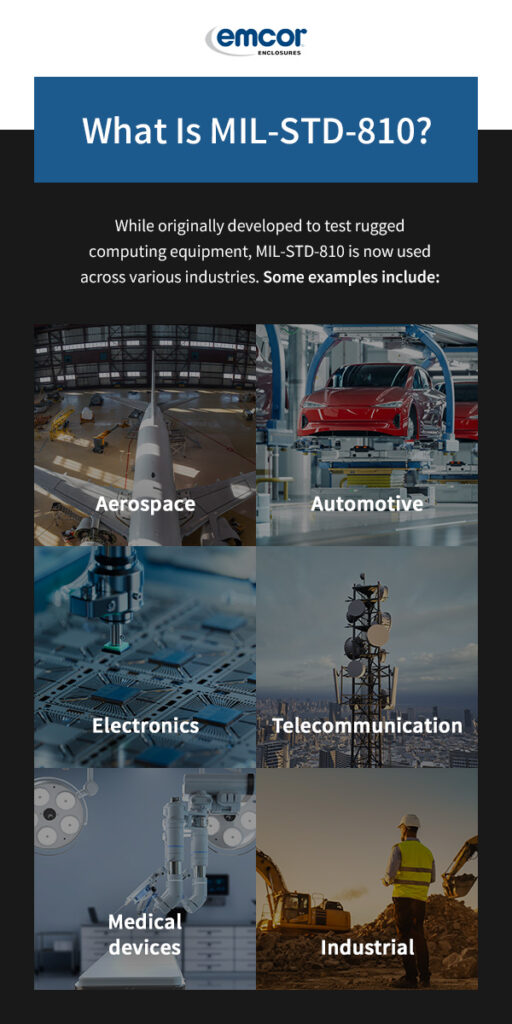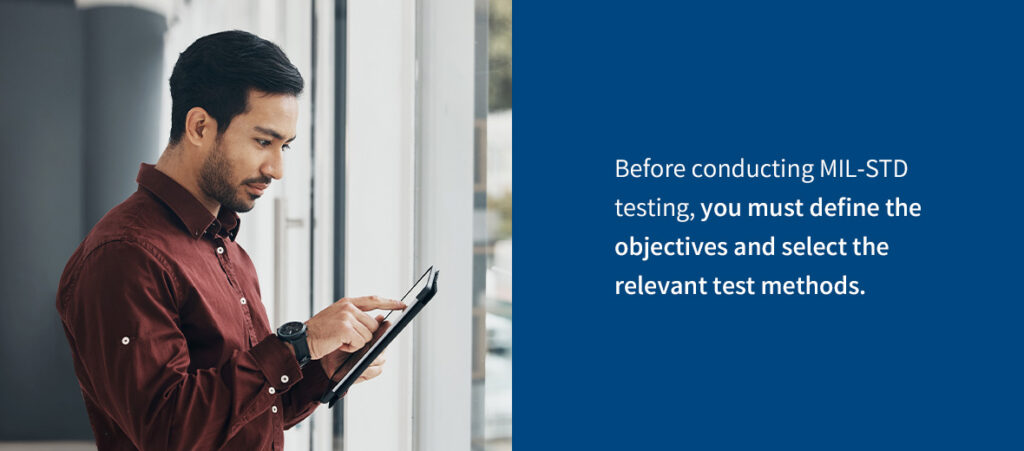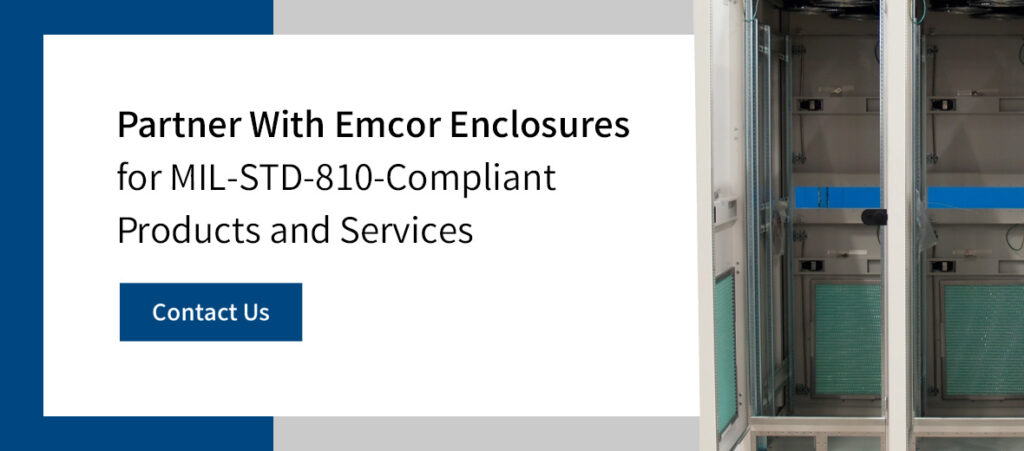MIL-STD-810 Standard and Testing Guide

MIL-STD-810 is a comprehensive standard that has developed over the years. Although originally designed for military applications, various industries are implementing these test protocols because they enhance product durability and reliance.
In our guide, you will learn what MIL-STD-810 entails, its history and evolution, and a breakdown of the test methods. Additionally, we cover testing procedures and protocols and how MIL-STD-810 compares to other standards, common challenges, best practices and emerging trends.
What Is MIL-STD-810?

MIL-STD-810 is a United States military standard used to ensure equipment is reliable and durable in various conditions. In other words, it is the framework used to test the effect the environment has on military equipment’s performance throughout its life cycle. MIL-STD-810, also known as the Test Method Standard for Environmental Engineering Considerations and Laboratory Tests, is enforced by the U.S. Department of Defense.
While originally developed to test rugged computing equipment, MIL-STD-810 is now used across various industries. Some examples include:
- Aerospace: Aircraft manufacturers use MIL-STD-810 for avionics, such as navigation systems. This testing method ensures components are reliable under varying atmospheric conditions.
- Automotive: Companies producing military-grade and off-road vehicles apply MIL-STD-810 to ensure durability against vibrations, shocks and environmental extremes.
- Electronics: Producers of consumer electronics, such as rugged laptops, smartphones and wearable devices, often test products against MIL-STD-810 to ensure durability for outdoor and industrial use.
- Telecommunication: Manufacturers of ruggedized communication devices like radios and satellite phones utilize MIL-STD-810 to validate performance in adverse environments.
- Medical devices: Manufacturers of medical devices, such as portable equipment used in military or emergencies, can test against MIL-STD-810 to ensure reliability in challenging environments.
- Industrial: Heavy industrial equipment manufacturers, such as construction and mining, can use MIL-STD-810 testing. Being able to withstand harsh conditions like dust, moisture and extreme temperatures can optimize performance.
Although compliance is optional for applications outside the military, companies in various other industries use the test standard because it gives them a marketing advantage. Users want quality products, and MIL-STD-810-compliant devices or components tick all the boxes. Moreover, some contracts require adherence to MIL-STD-810, in which case it becomes mandatory.
The History and Evolution of MIL-STD-810
MIL-STD-810 was introduced in the 1960s. The first edition was released in 1962 to standardize testing methods for military equipment and allow users to modify tests to reflect environmental conditions. This initiative was crucial because there was no uniform approach to environmental testing at the time.
Since it was first introduced, the standard has evolved as summarized below:
- MIL-STD-810A in 1964
- MIL-STD-810B in 1967
- MIL-STD-810C in 1975
- MIL-STD-810D in 1983
- MIL-STD-810E in 1989
- MIL-STD-810F in 2000
- MIL-STD-810G in 2008
- MIL-STD-810H in 2019
The current version covers a wide range of environmental circumstances to determine the overall durability and ruggedness of equipment. MIL-STD-810H has three parts:
- Environmental engineering program guidelines: Part one describes the engineering, management and technical roles in the testing process and environmental design. It requires companies to tailor the testing criteria and material design to the likely environmental conditions.
- Laboratory test methods: Part two defines the environmental laboratory test methods applicable to part one guidelines. Except for test method 528, the methods are optional. Each test method contains data and references with possible tailoring opportunities.
- World climate regions: Part three contains comprehensive climate data from global sources. The climate data assists in the research and development, testing, and evaluation of the item’s life cycle when used in different regions worldwide.
These rigorous testing requirements help determine whether the equipment is optimized for use in the intended environment.
MIL-STD-810 Test Methods
MIL-STD-810 contains several comprehensive test methods, each addressing a condition or combination of conditions.
1. Environmental Testing
One set of testing methods is related to the following environmental conditions:
- Altitude: Test method 500.6 relates to low pressure or altitudes. It tests the product’s ability to withstand low and rapid pressure changes. It usually applies to materials deployed to pressurized and unpressurized areas in aircraft.
- High temperature: Test method 501.7 evaluates the impact of high temperatures on the integrity, safety and performance of materials. It is ideal for materials deployed to regions where temperatures exceed the standard ambient. The tests are performed in high-temperature testing laboratories.
- Low temperature: Test method 502.7 evaluates the impact of low temperatures on the integrity, safety and performance of materials. It is ideal for materials deployed to low-temperature environments during their life cycle. The procedures include storage, operational and manipulation tests.
- Temperature shock: Test method 503.7 evaluates the impact of sudden temperature changes on the material. A sudden temperature change is defined as a change in air temperature greater than 50 degrees Fahrenheit within one minute. The purpose is to determine whether the material can perform in such conditions without physical damage or deterioration.
- Solar radiation: Test method 505.7 tests equipment against solar radiation and sunshine. The purpose is to identify the actinic effects of the exposure, which can cause paint fading, electronic component failure and loss of seal integrity.
- Humidity: Test method 507.6 addresses the application or storage of products in humid conditions. In other words, it tests the material’s ability to resist the impacts of a warm, humid atmosphere. This test is essential because humid environments can provoke chemical reactions, impacting performance and integrity.
- Rain: Test method 506.6 tests the material’s ability to withstand rain, dripping water or water spray without damage. It helps determine the reliability and durability of protective cases, covers and seals to prevent rain ingress. This test is usually optional when the material passes the immersion test.
- Icing and freezing rain: Test method 521.4 tests the product against freezing conditions. It also addresses how operators can defrost the product while maintaining its operational capacity. Ice can impact products, including binding moving parts and inducing structural failures.
- Freeze-thaw: Test method 524.1 examines the product’s ability to withstand moisture transitions from solid to liquid and vice versa. The technician simulates various thawing and freezing conditions with moisture, ice and condensation to determine the impact on the product. This method helps evaluate product performance when transferred between cold-to-warm and warm-to-cold regions.
- Sand and dust: Test method 510.7 tests the performance of materials in sandy and dusty conditions. It usually applies to products deployed in hot climates. The focus is on openings, crevices and the effectiveness of filters.
2. Mechanical Testing

The MIL-STD-810 mechanical testing methods include:
- Acceleration: Test method 513.8 ensures the product can structurally withstand steady inertia loads. The condition is induced by platform acceleration, deceleration and maneuvering. The test method is ideal for materials installed on aircraft.
- Vibration: Test method 514.8 is a standard for conducting vibration laboratory tests. It examines the impact of vibration on the product’s operational and physical performance and integrity. The procedure is best for applications like rotary and fixed-wing aircraft.
- Acoustic noise: Test method 515.8 simulates acoustic conditions capable of causing airborne pressure fluctuations. The procedure is conducted in an acoustic testing lab and examines the material’s structural and functional performance in such environments.
- Shock: Test method 516.8 focuses on the product’s ability to withstand mechanically induced shocks. The test helps determine the product’s safety and fragility levels during handling and transportation.
- Pyroshock: Test method 517.3 involves explosives or pyrotechnic devices. It determines whether the equipment can withstand infrequent shock effects and the possible implications. A common problem associated with pyroshock is material failure.
- Gunfire shock: Test method 519.8 applies specifically to shocks resulting from gunfire. It tests the material’s resistance against gunfire schedules, which are the firing rate, rounds fired and number of firing events. Three procedures outline the test conditions for monitoring signs of wear, electronic malfunction and material failure.
- Ballistic shock: Test method 522 is another variation of a shock test. The focus is on the material’s ability to withstand shocks from elevated momentum exchanges. It contains six procedures outlining the shock frequencies and attributes for testing devices.
- Rail impact: Test method 526.2 tests the material’s resistance to railroad car impacts during transportation. It considers damage to the product as well as potential safety hazards during a collision.
- Mechanical vibrations of shipboard equipment: Test method 528 specifies the procedures for naval shipboard equipment subject to mechanical vibrations. It sets the requirements for environmental and internally excited vibration testing. While designed for naval ships, the test can be tailored for non-conventional propulsors on waterjets and other systems.
3. Other Tests
The MIL-STD-810 standard has other test methods, which are:
- Contamination by fluids: Test method 504.3 exposes materials to contaminating fluids to determine the physical, electrical and chemical impacts. MIL-STD-810 has a long list of contaminating fluids, including antifreeze, lubricant and diesel fuel. The exposure could be temporary, intermittent or extended depending on the expected life cycle scenario.
- Fungus: Test method 508.8 tests materials’ sensitivity to fungal growth. Technicians select spores from certain fungus species and expose the material to allow germination. This assessment is crucial because fungal growth can change the product’s physical properties and function.
- Salt fog: Test method 509.7 assesses the effectiveness of protective finishes and coatings on materials. By exposing the material to environments with high salt levels, technicians can determine how those conditions affect the physical and electrical components. Salt fog testing focuses on corrosion resistance.
- Explosive atmosphere: Test method 511.7 applies to products deployed on vehicles or aircraft where flammable vapor can originate either from the product or external sources. The purpose is to ensure the product will not cause a burning reaction or ignition in fuel-air atmospheres.
- Immersion: Test method 512.7 examines the performance and integrity of products when submerged in water. It is ideal for products often exposed to water ingress during their life cycle. Buoyant items are usually excluded from this test unless they can be held underwater for special applications.
- Acidic atmosphere: Test method 518.2 tests the product’s resistance to corrosive atmospheres. It focuses on the reliability of protective coatings and the product’s operational capabilities when exposed to such environments. Acidic atmospheres are usually present in industrial areas or near the exhaust of fuel-burning devices or vehicles.
- Temperature, humidity, vibration and altitude: Test method 520.5 combines four conditions — temperature, humidity, vibration and altitude. The purpose is to determine the synergistic impacts of adverse environments on the products. It does not replace the specific conditions but evaluates their combined effects.
- Vibro-acoustic and temperature: Test method 523.4 combines three conditions — vibration, acoustic noise and temperature. It focuses on aircraft stores during flights to identify defects and weaknesses in design.
- Time waveform replication: Test method 525 ensures the product can withstand test time traces and estimates the material’s fragility level. The test focuses on the level, duration, form and repeated application of the test time traces.
- Multi-exciter: Test method 527 simulates a dynamic environment within the lab. It applies multiple stress factors to determine how long it takes the material to show signs of weakness.
Testing Procedures and Protocols
The MIL-STD-810 testing procedures and protocols involve:
1. Preparation for Testing

Before conducting MIL-STD testing, you must define the objectives and select the relevant test methods. This process helps you develop a practical test plan. Once the plan is complete, you can prepare the equipment for testing. Equipment preparation involves two steps:
- Conducting pre-test inspections to ensure the equipment is in good physical condition.
- Calibrating instruments and sensors as needed.
The next step is preparing the testing facility, ensuring compliance with MIL-STD-810 specifications to conduct pre-testing measurements successfully.
2. Execution of Tests
Follow the specific procedure outlined in MIL-STD-810 for each test method. Continuously monitor the environmental conditions within the change and record deviations from planned parameters. Conduct post-test evaluations to determine damage or performance degradation. Finally, compare the pre- and post-performance data to assess compliance.
3. Documentation and Reporting
Compile detailed records throughout the testing process. Take note of points such as:
- Test configurations
- Environmental conduction during tests
- Observations during testing, such as anomalies and failures
- Pre and post-test performance data
Prepare a report based on the information you have collected and submit it to the relevant stakeholders. Lastly, address feedback and make the necessary revisions before finalizing the documentation.
MIL-STD-810 Compared to Other Standards
MIL-STD-810 is highly regarded due to its stringent standards. Although it is primarily designed for military applications, many industries have adopted MIL-STD-810 for various products. It has rigorous testing methods like some IEC/ISO standards, such as ISO 9001 and 60068.
Challenges and Best Practices
MIL-STD-810 implementation can be complex. It is resource-intensive and can sometimes lead to over-engineering. To navigate these challenges, technicians can tailor the testing methods to suit your application, avoiding unnecessary procedures and expenses. Additionally, you can work with vendors that are MIL-STD-810 compliant.
Future Trends in MIL-STD-810 Testing
MIL-STD-810 has evolved over the years and will continue to develop. Below are some trends and expected changes:
- Integration of advanced technologies: As technologies are introduced, the standards will likely change to accommodate new testing methods.
- Increased focus on sustainability: Considering the growth in sustainable initiatives, subsequent amendments will potentially prioritize environmentally friendly testing methods and materials.
- Enhanced customizations and flexibility: Future versions of MIL-STD-810 may emphasize test customization based on specific mission profiles or operational environments.
- Collaboration across industries: Increased collaboration between the military and commercial sectors can lead to shared best practices in testing methodologies.
Partner With Emcor Enclosures for MIL-STD-810-Compliant Products and Services
Emcor Enclosures understands the value MIL-STD-810 brings to the industry. Whether you work on military projects or in other sectors, we can help you comply with the standard. We provide high-quality shielded enclosures and accessories designed for various applications, tested to military standards. Our offerings include standard and customized metal cabinets and racks for server and network equipment racks.
Emcor Enclosures has decades of experience, skilled technicians and a world-class facility capable of executing diverse projects. We dedicate time and attention to addressing client needs and exceed expectations. Contact us today for professional assistance!
